Hydrangea garden design brings a splash of color and charm to any outdoor space. With their stunning blooms and varied sizes, hydrangeas can create everything from cozy cottage gardens to elegant landscapes. This guide will help you choose the right types, colors, and layouts to make the most of these gorgeous plants in your garden.
Using Hydrangeas for Privacy Screens
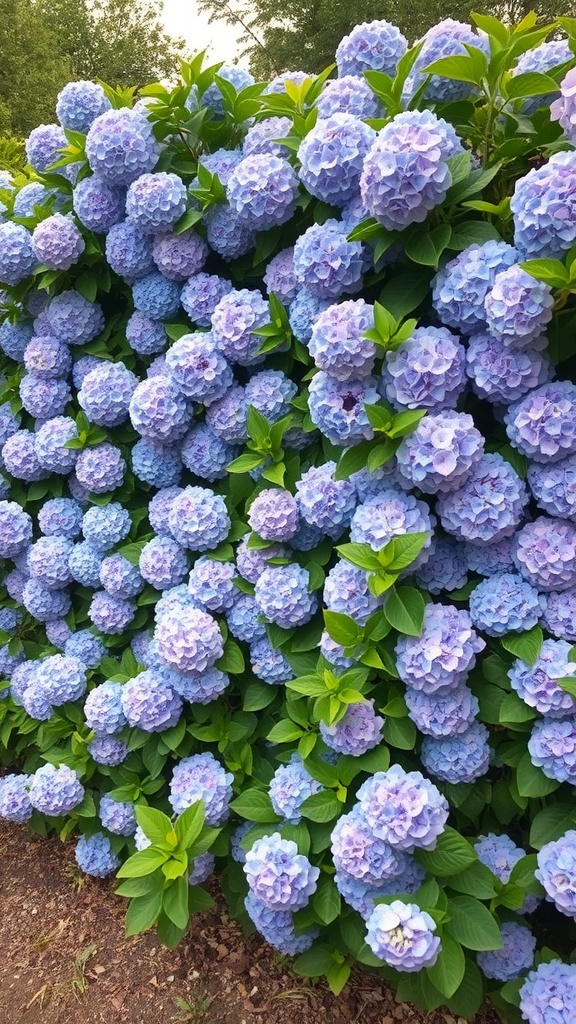
Hydrangeas are a fantastic choice for creating privacy screens in your garden. Their lush foliage and vibrant blooms can form a beautiful barrier that not only blocks views but also adds charm to your outdoor space.
The image shows a stunning display of hydrangeas, bursting with clusters of blue and purple flowers. This dense growth creates a natural wall that can shield your yard from prying eyes. The colors are eye-catching, making the garden feel lively and inviting.
When planting hydrangeas for privacy, consider their height and spread. They can grow tall enough to provide coverage while still being manageable. Plus, they thrive in various soil types, making them versatile for different garden settings.
To maintain their shape and health, regular pruning is key. This will encourage new growth and help keep your privacy screen looking its best. With the right care, your hydrangeas will flourish, creating a stunning backdrop for your garden.
Designing with Hydrangeas for Seasonal Interest
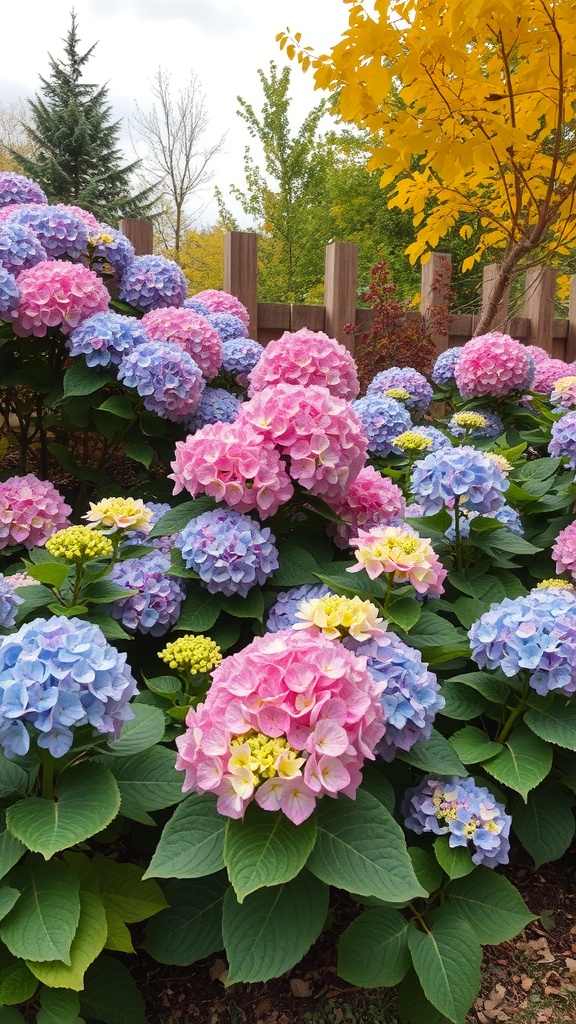
Hydrangeas are a fantastic choice for any garden, bringing a splash of color and texture throughout the seasons. In the image, you can see a vibrant display of hydrangeas in shades of pink and blue, surrounded by lush green leaves. This combination creates a lively atmosphere that draws the eye.
These flowers bloom in various colors, depending on the soil’s pH. This means you can customize your garden’s look by adjusting the soil. The pink and blue hues in the image show how versatile hydrangeas can be, making them a fun addition to any landscape.
In the background, you can spot trees with golden leaves, hinting at the changing seasons. This contrast highlights how hydrangeas can stand out, even as the landscape shifts. They can thrive in both sunny and partially shaded areas, making them adaptable to different garden designs.
When planning your garden, think about mixing hydrangeas with other plants for added depth. Pairing them with evergreens or seasonal flowers can create a stunning visual effect. The key is to consider how the colors and textures will work together throughout the year.
Choosing the Right Hydrangea Varieties
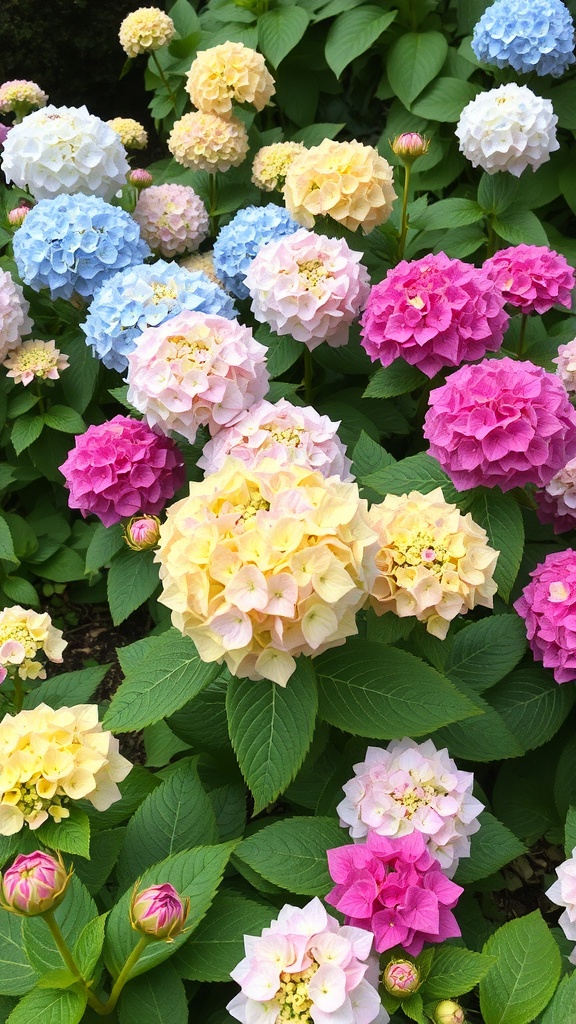
When planning a hydrangea garden, picking the right varieties is key. The image shows a stunning mix of hydrangeas in various colors, showcasing their beauty and diversity. These flowers can transform any garden space into a vibrant oasis.
Hydrangeas come in many types, including mophead, lacecap, and panicle. Each type has its unique charm. Mophead hydrangeas, with their large, round blooms, are perfect for a bold statement. Lacecap varieties offer a delicate look with their flat flower heads, while panicle hydrangeas are known for their cone-shaped clusters.
Color is another factor to consider. Some hydrangeas change color based on soil pH. For example, blue blooms thrive in acidic soil, while pink ones prefer alkaline conditions. This feature allows for creative gardening, as you can adjust colors by changing the soil.
Lastly, think about the growing conditions in your garden. Some varieties prefer full sun, while others thrive in partial shade. Knowing your garden’s light and moisture levels will help you choose the best hydrangeas for your space.
Pairing Hydrangeas with Perennials
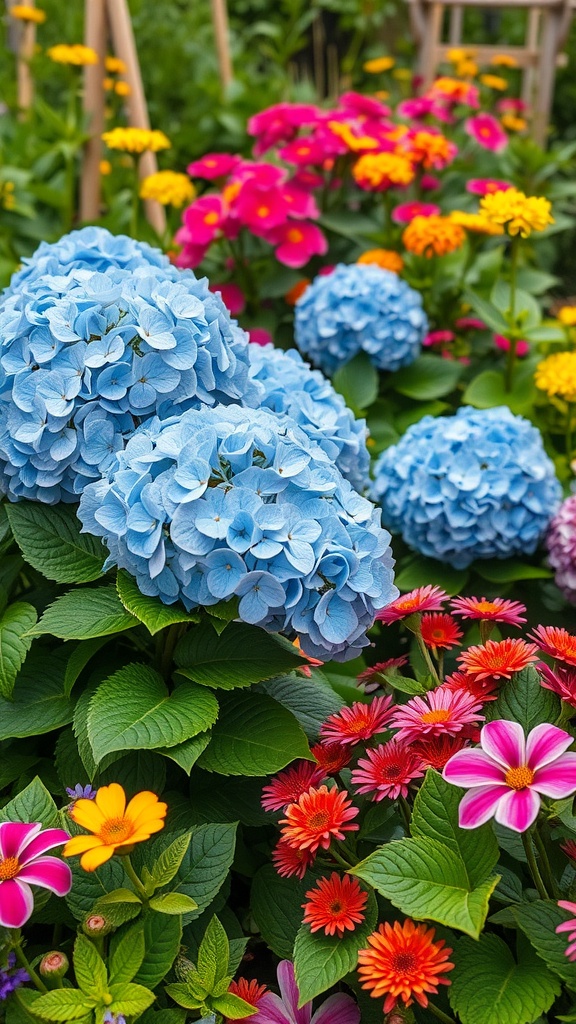
Hydrangeas are a stunning choice for any garden, and they pair beautifully with perennials. In the image, you can see vibrant blue hydrangeas surrounded by a colorful mix of flowers. This combination creates a lively and inviting atmosphere.
When choosing perennials to complement hydrangeas, consider their blooming times. Flowers like daisies and zinnias can add bursts of color that enhance the hydrangeas’ beauty. The bright oranges and pinks in the image contrast nicely with the soft blue of the hydrangeas, making the garden pop.
Another tip is to think about the foliage. The lush green leaves of hydrangeas provide a great backdrop for the colorful blooms of perennials. This balance helps create a cohesive look in your garden. Mixing different heights and shapes can also add visual interest.
Don’t forget about the seasons! Some perennials bloom in spring, while others may flower in summer or fall. This way, your garden can look beautiful all year round. By carefully selecting your plants, you can create a stunning hydrangea garden that is both colorful and harmonious.
Creating a Color Palette with Hydrangeas
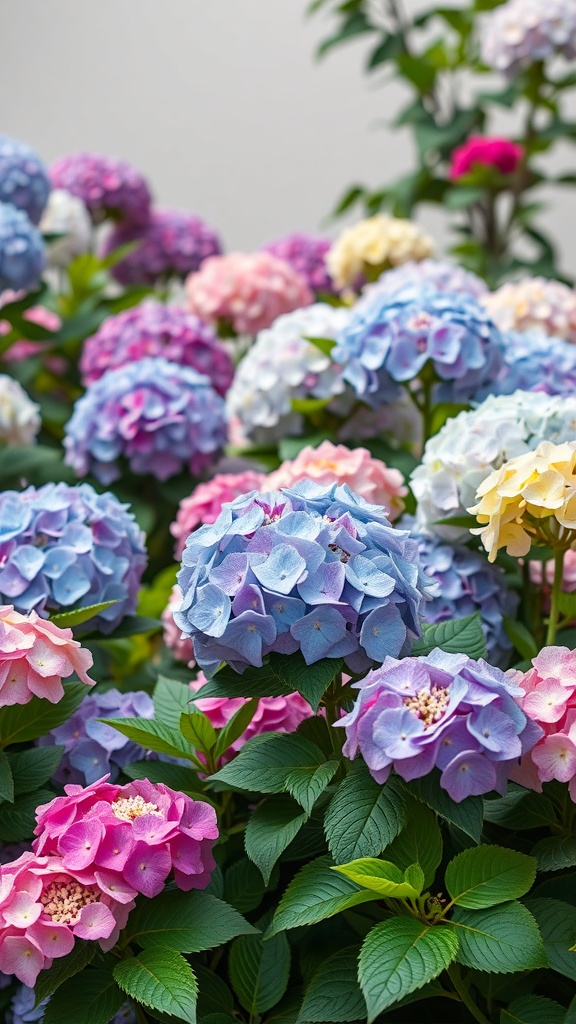
Hydrangeas are a fantastic choice for adding color to your garden. With their large, fluffy blooms, they come in a variety of shades, making it easy to create a stunning color palette. The image shows a vibrant mix of blues, pinks, purples, and soft yellows, showcasing how these flowers can brighten up any space.
When planning your garden, think about how these colors can work together. For instance, pairing blue hydrangeas with pink ones can create a lovely contrast. You can also mix in some white or cream varieties to add a touch of elegance. The soft hues of the flowers can complement each other beautifully, creating a serene atmosphere.
Consider the placement of your hydrangeas as well. Grouping them in clusters can enhance their visual impact. You might want to create sections in your garden where similar colors are grouped together. This can help create a cohesive look that draws the eye and invites exploration.
Don’t forget about the foliage! The green leaves of hydrangeas provide a nice backdrop that makes the colors pop even more. By carefully selecting your hydrangea varieties and their placements, you can create a stunning garden that feels both inviting and harmonious.
Hydrangeas as Focal Points in Landscape Design
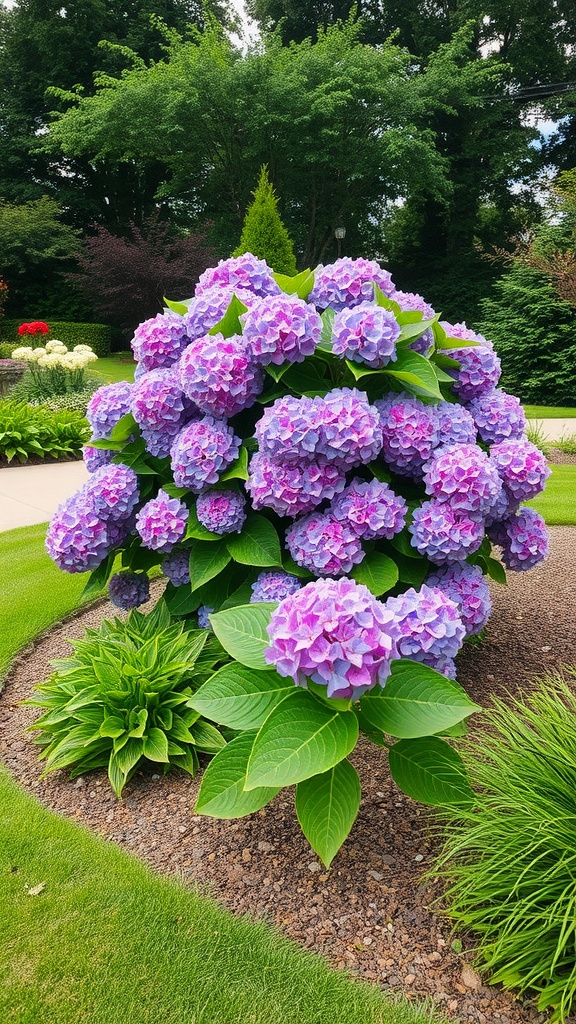
Hydrangeas are stunning plants that can truly transform a garden. Their large, colorful blooms catch the eye and create a vibrant focal point. In the image, we see a lush hydrangea bush bursting with shades of purple and blue. This striking display stands out beautifully against the green backdrop of trees and grass.
Using hydrangeas in your landscape design can add depth and interest. They work well in various settings, whether in a formal garden or a more casual space. The round shape of the bush complements other plants, like the hostas nearby, creating a balanced look.
When planning your garden, think about where to place hydrangeas. They thrive in partial shade and can create a lovely contrast with sun-loving plants. This way, you can enjoy their beauty throughout the growing season.
Incorporating hydrangeas as focal points not only enhances the visual appeal but also invites visitors to explore your garden. Their rich colors and lush foliage make them a favorite among gardeners and nature lovers alike.
Creating a Hydrangea-Centric Flower Bed
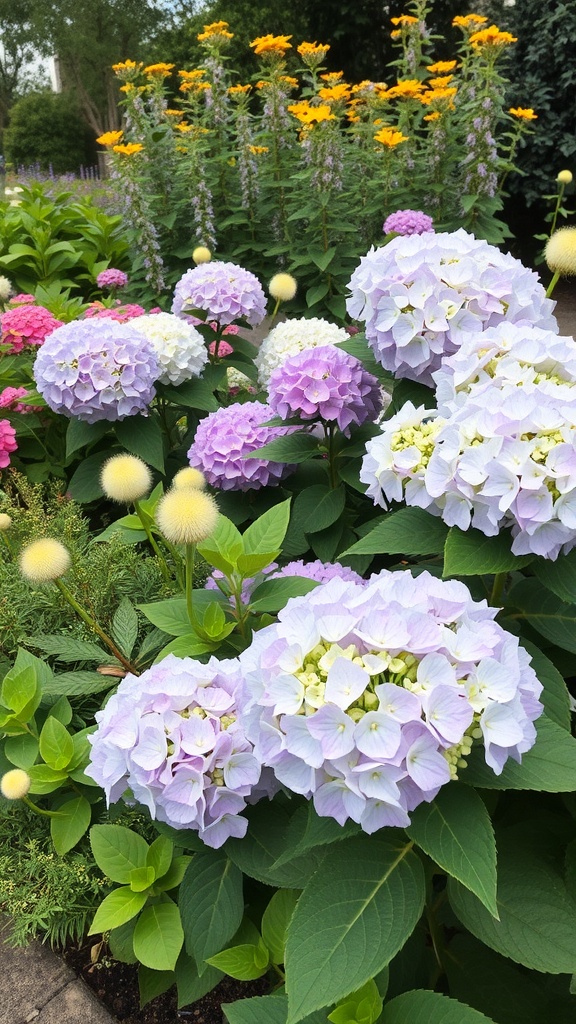
When designing a flower bed focused on hydrangeas, it’s all about showcasing their beauty. The image captures a stunning display of hydrangeas in various shades, from soft lavender to bright pink and white. These flowers create a lovely focal point in any garden.
To start, choose a variety of hydrangeas that bloom at different times. This ensures that your flower bed stays vibrant throughout the growing season. Mixing colors adds depth and visual interest. The soft hues of the hydrangeas in the image blend beautifully with the yellow flowers in the background, creating a cheerful atmosphere.
Consider the layout of your flower bed. Plant taller varieties at the back and shorter ones in front. This arrangement allows every flower to shine. The lush green leaves of the hydrangeas provide a nice contrast to the colorful blooms, making the entire bed pop.
Don’t forget about companion plants! The yellow flowers in the background complement the hydrangeas perfectly. Choose plants that thrive in similar conditions to keep maintenance easy. With the right mix, your hydrangea-centric flower bed will be a delightful sight.
Incorporating Hydrangeas into Mixed Borders
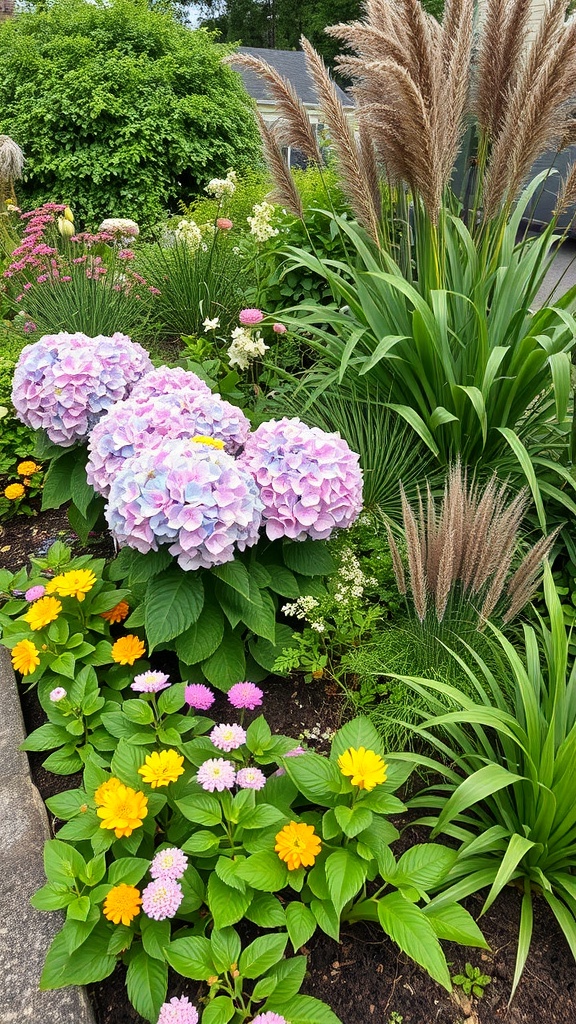
Hydrangeas are a fantastic choice for mixed borders. Their large, colorful blooms can really make a statement. In the image, you can see beautiful clusters of hydrangeas in shades of pink and blue, surrounded by a variety of other plants. This creates a lively and inviting scene.
Mixing hydrangeas with other flowers, like the cheerful yellow and pink blooms in the foreground, adds depth and interest. The different textures and colors work together beautifully. The tall grasses in the background provide a nice contrast, adding height and movement to the garden.
When planning your border, think about the height and spread of each plant. Hydrangeas can grow quite large, so placing them towards the back or center of the border works well. This way, smaller flowers can shine in front of them. Don’t forget to consider the light and water needs of each plant to keep everything thriving.
Incorporating hydrangeas into your garden design not only enhances the visual appeal but also offers a variety of blooms throughout the season. With a little planning, you can create a stunning mixed border that showcases these lovely flowers.
Incorporating Hydrangeas in Cottage Gardens
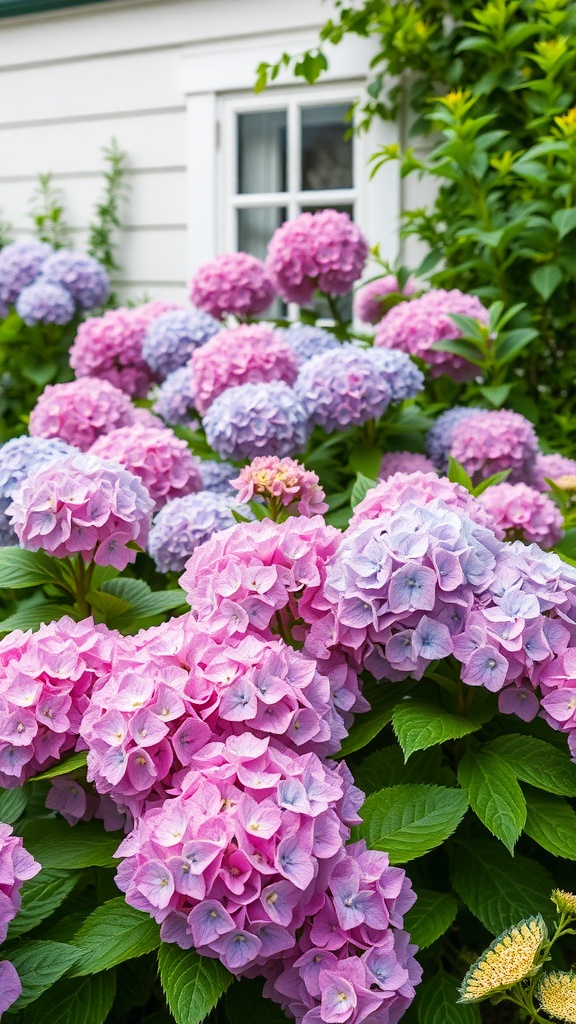
Hydrangeas are a perfect fit for cottage gardens, bringing a splash of color and charm. The image shows vibrant clusters of pink and blue hydrangeas, creating a soft, inviting look. These flowers thrive in various conditions, making them versatile for different garden designs.
When planning your cottage garden, consider grouping hydrangeas with other flowering plants. Their round blooms can complement the delicate petals of other flowers, adding depth and interest. The lush green leaves also provide a beautiful backdrop, enhancing the overall aesthetic.
Position hydrangeas near pathways or windows to enjoy their beauty up close. They can also serve as natural dividers in your garden, guiding visitors through your space. With their rich colors, these flowers can brighten any corner, making your garden feel cozy and welcoming.
Creating a Hydrangea-Themed Garden Room
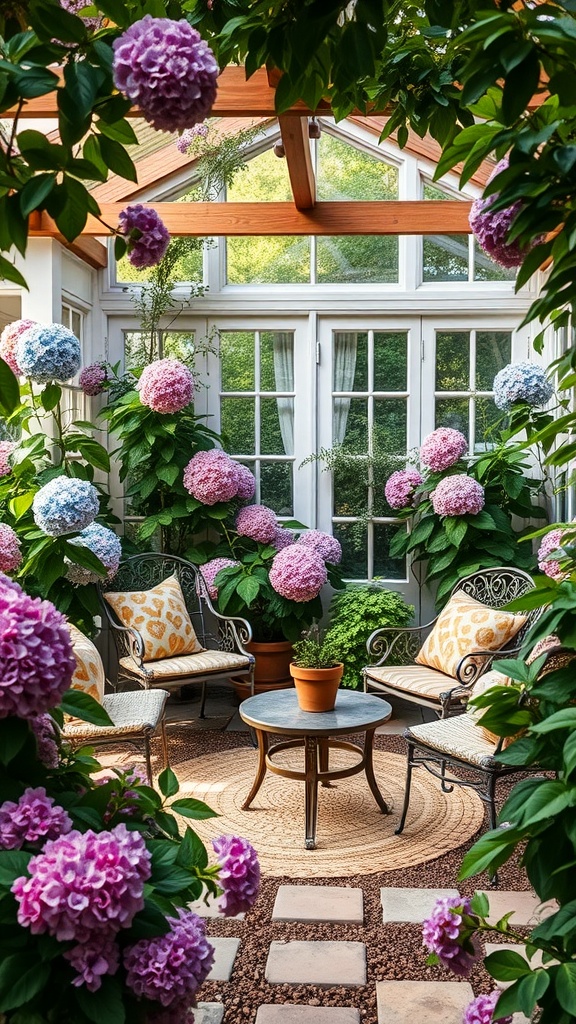
Imagine stepping into a cozy garden room filled with the charm of hydrangeas. The image showcases a delightful space where these beautiful flowers take center stage. With their lush blooms in shades of pink and blue, hydrangeas create a vibrant atmosphere.
The room features comfortable seating, inviting you to relax and enjoy the view. The natural light streaming through the windows enhances the colors of the flowers, making everything feel warm and welcoming. A round table sits in the middle, perfect for enjoying a cup of tea or a good book.
Surrounded by greenery, this garden room is a perfect retreat. The combination of hydrangeas and cozy furniture makes it an ideal spot for gatherings or quiet moments. Whether you’re entertaining friends or simply enjoying nature, this space is designed for comfort and beauty.
Hydrangeas in Container Gardening
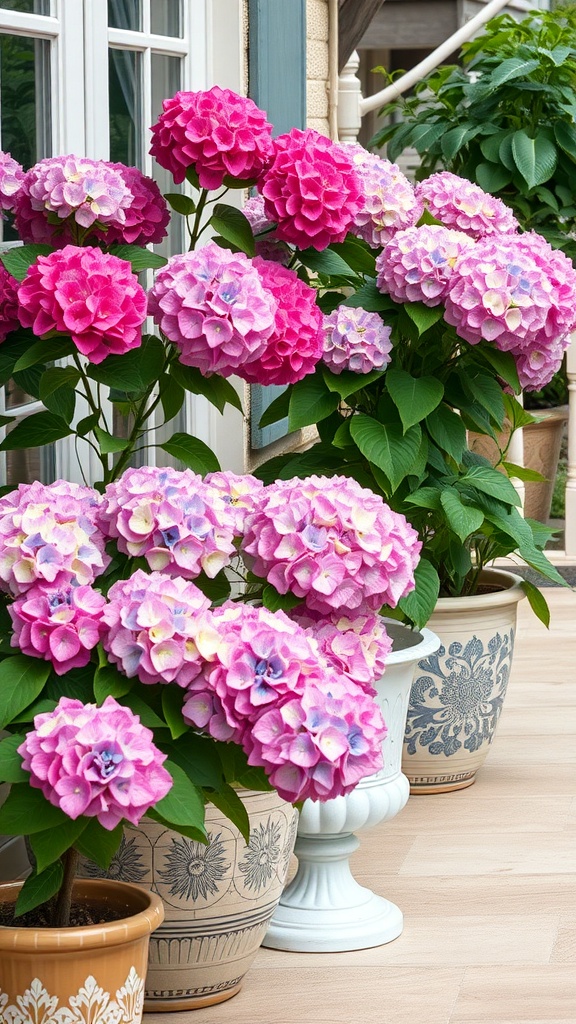
Container gardening is a fantastic way to showcase hydrangeas. These beautiful flowers can brighten up any space, whether it’s a patio, balcony, or garden. In the image, you can see vibrant pink hydrangeas in various decorative pots. The colors range from deep pink to soft lavender, creating a stunning visual display.
Using containers allows you to control the soil and drainage, which is key for hydrangeas. They thrive in well-drained soil and appreciate a good amount of water. The pots in the image are not just functional; they add style to the overall look. Mixing different pot styles can create a charming, eclectic vibe.
Positioning your containers is also important. Placing them near a window or in a spot that gets partial shade can help the plants flourish. The hydrangeas in the image seem to be enjoying a sunny spot, which is perfect for their growth. Remember to check the moisture level regularly, as container plants can dry out faster than those in the ground.
Finally, don’t forget to consider the size of your containers. Larger pots can accommodate bigger hydrangea varieties, while smaller ones are great for compact types. With the right care, these beautiful blooms can be a delightful addition to your home.
Hydrangeas for Pollinator-Friendly Gardens
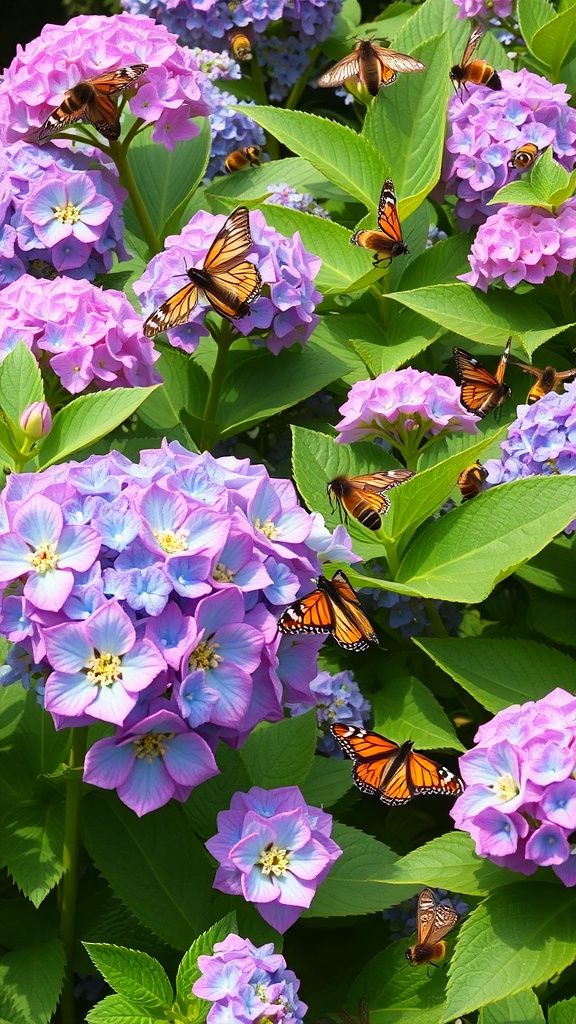
Hydrangeas are not just beautiful; they also play a key role in attracting pollinators. The image showcases vibrant clusters of hydrangeas in shades of pink and blue, surrounded by fluttering butterflies. This scene is a perfect example of how these flowers can create a lively garden atmosphere.
Butterflies, bees, and other pollinators are drawn to hydrangeas due to their rich nectar. When you plant these flowers, you’re inviting a variety of these helpful creatures into your garden. This not only enhances the beauty of your space but also supports local ecosystems.
To make your garden even more inviting, consider grouping hydrangeas together. This creates a stunning visual effect while providing a concentrated source of food for pollinators. Mixing different varieties can also add depth and interest to your garden.
Choosing the right location is essential. Hydrangeas thrive in areas with partial shade and well-drained soil. By placing them strategically, you can create a cozy spot for butterflies to rest and feed. Remember, a pollinator-friendly garden is a happy garden!
Designing a Hydrangea Pathway
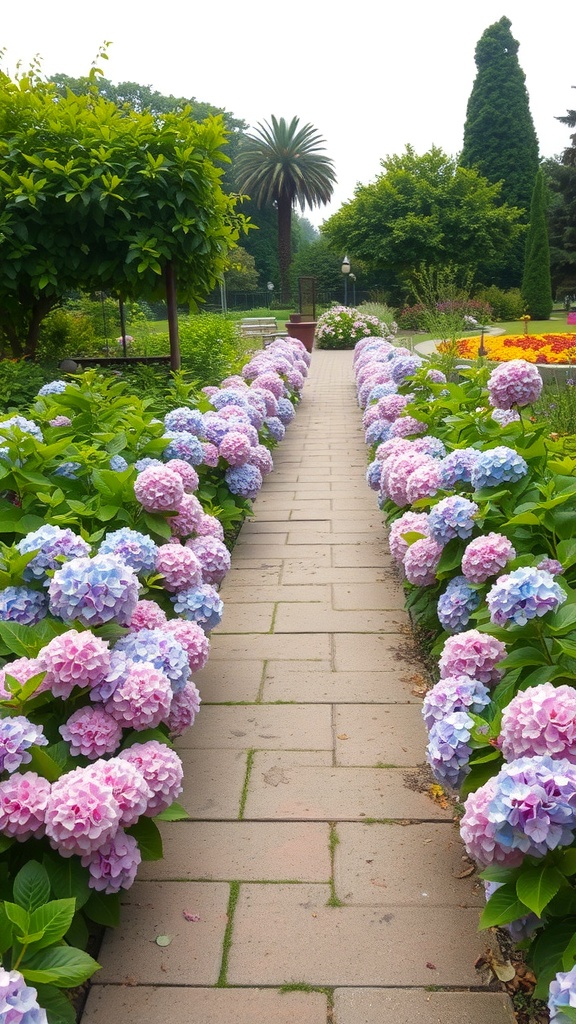
Creating a hydrangea pathway is a delightful way to enhance your garden. Imagine walking down a path lined with vibrant blooms. The soft colors of pink and blue hydrangeas create a welcoming atmosphere.
The pathway itself can be made of simple pavers, allowing the flowers to shine. This design invites visitors to stroll and enjoy the beauty around them. The lush greenery complements the flowers, adding depth to the scene.
Consider the spacing of the hydrangeas. Plant them close enough to form a colorful border, but leave room for growth. This ensures a full display without overcrowding. Adding some taller plants or trees in the background can create a lovely backdrop, making the pathway feel even more inviting.
Lighting can also play a role. Soft garden lights along the path can highlight the flowers at night, creating a magical feel. A hydrangea pathway is not just a way to connect different areas of your garden; it’s a beautiful experience for anyone who walks through.
Hydrangeas in Shade Gardens
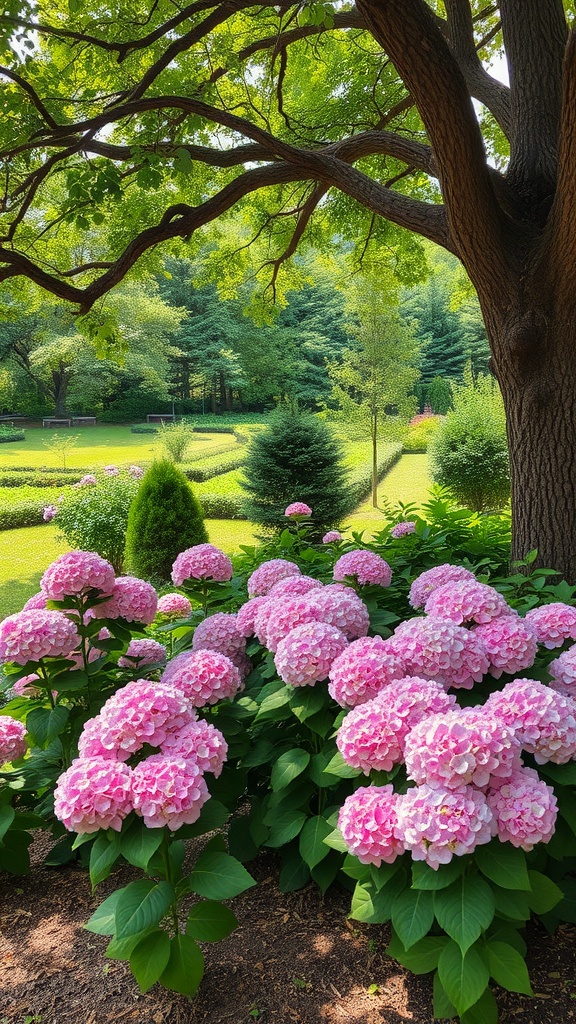
Hydrangeas thrive in shade gardens, bringing a splash of color to darker areas. The image shows a beautiful cluster of pink hydrangeas, their large blooms standing out against lush green foliage. This combination creates a serene and inviting atmosphere.
Shade gardens can be tricky, but hydrangeas make it easier. They prefer partial to full shade, which allows them to flourish without the harsh sun. The vibrant pinks of the flowers contrast nicely with the deep greens of the surrounding plants and trees.
In this garden, the hydrangeas are strategically placed, enhancing the overall design. They can serve as focal points or borders, guiding the eye through the landscape. The layers of greenery in the background add depth and texture, making the garden feel more alive.
When designing a shade garden, think about the placement of hydrangeas. They can create a cozy nook or a stunning backdrop. Pair them with other shade-loving plants for a diverse and colorful display. With the right care, these flowers will bloom beautifully, making your garden a peaceful retreat.
Utilizing Hydrangeas for Vertical Gardening
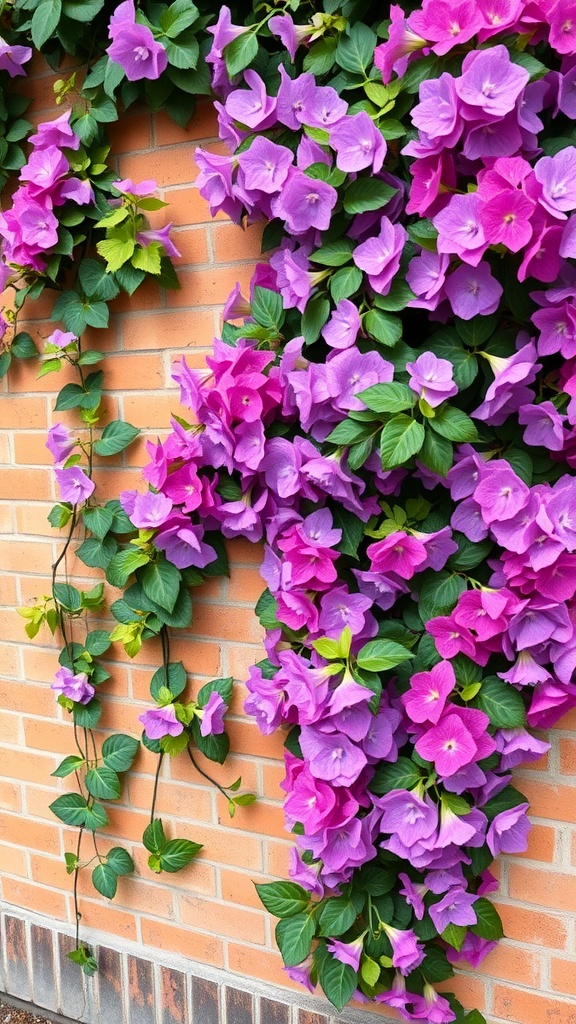
Hydrangeas can be a stunning choice for vertical gardening. Their lush blooms and vibrant colors add a splash of beauty to any wall or fence. When climbing or trailing varieties are used, they can create a gorgeous tapestry of flowers that draws the eye upward.
In the image, you see a wall adorned with vibrant pink flowers against a warm brick background. This setup is a perfect example of how hydrangeas can soften hard surfaces and bring life to vertical spaces. The lush green leaves complement the colorful blooms, creating a lively contrast.
Vertical gardening with hydrangeas not only maximizes space but also enhances the overall garden design. By training these plants to climb or cascade, you can create a unique focal point in your outdoor area. Whether you have a small balcony or a spacious garden, hydrangeas can fit beautifully into your design.
Consider using trellises or wall planters to support the growth of your hydrangeas. This approach allows them to flourish while also providing structure. With the right care, these plants can thrive and offer stunning blooms throughout the growing season.
Hydrangeas and Garden Art Integration
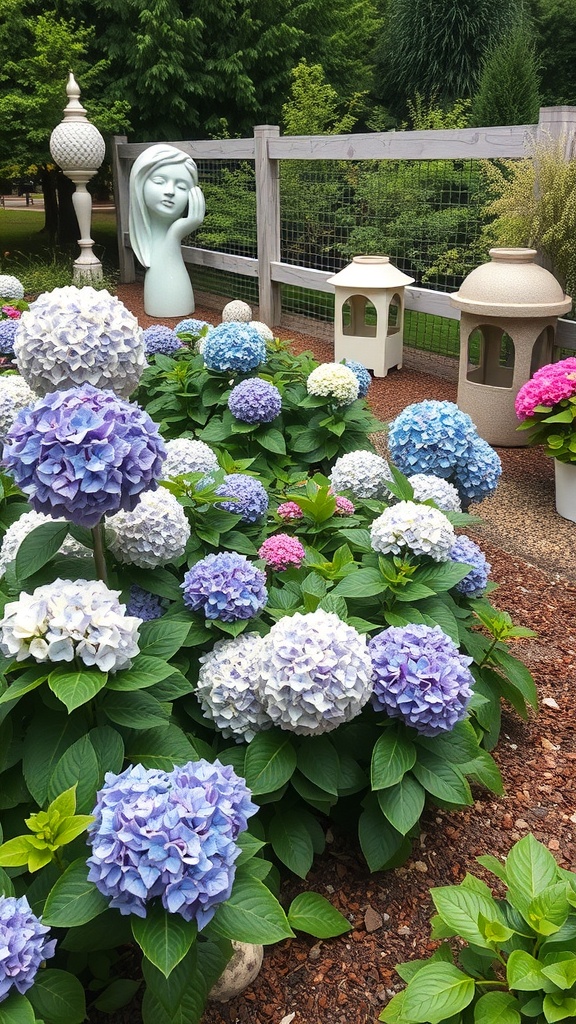
Hydrangeas are stunning flowers that can transform any garden into a colorful paradise. Their large, round blooms come in various shades, from soft blues to vibrant pinks. This variety allows for creative combinations with garden art, enhancing the overall look of your outdoor space.
In the image, you can see a lovely arrangement of hydrangeas surrounded by charming garden art. The sculpture of a woman adds a unique touch, creating a focal point that draws the eye. This kind of integration makes the garden feel more personal and inviting.
Lanterns placed among the flowers provide a cozy vibe, especially in the evenings. They illuminate the beauty of the hydrangeas while adding a warm glow. Mixing different elements like plants and art pieces can elevate your garden design.
When planning your garden, think about how you can blend flowers with art. Whether it’s sculptures, decorative pots, or lighting, the right pieces can enhance the natural beauty of hydrangeas and create a serene atmosphere.
Hydrangeas in Urban Gardening
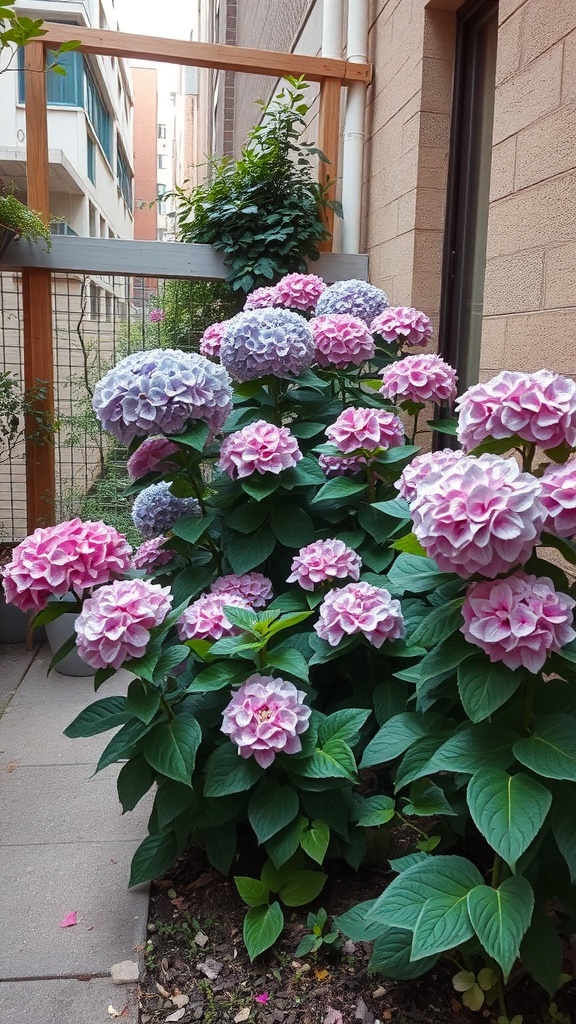
Hydrangeas are a fantastic choice for urban gardening. Their vibrant blooms can bring life to any small space. In the image, you can see a lovely arrangement of hydrangeas, showcasing shades of pink and purple. These colors can brighten up a narrow garden or balcony.
Urban environments often lack greenery, making hydrangeas a perfect solution. They thrive in pots and can fit into tight corners. The lush leaves and large flower heads create a stunning visual impact, even in limited areas.
These flowers are also relatively easy to care for. They need regular watering and some sunlight, which makes them ideal for busy city dwellers. With the right conditions, they can bloom beautifully from spring to fall.
Incorporating hydrangeas into your urban garden can transform a simple space into a vibrant retreat. Whether you have a balcony, patio, or small yard, these flowers can add charm and color.
Hydrangeas as Cut Flowers in Landscape Design
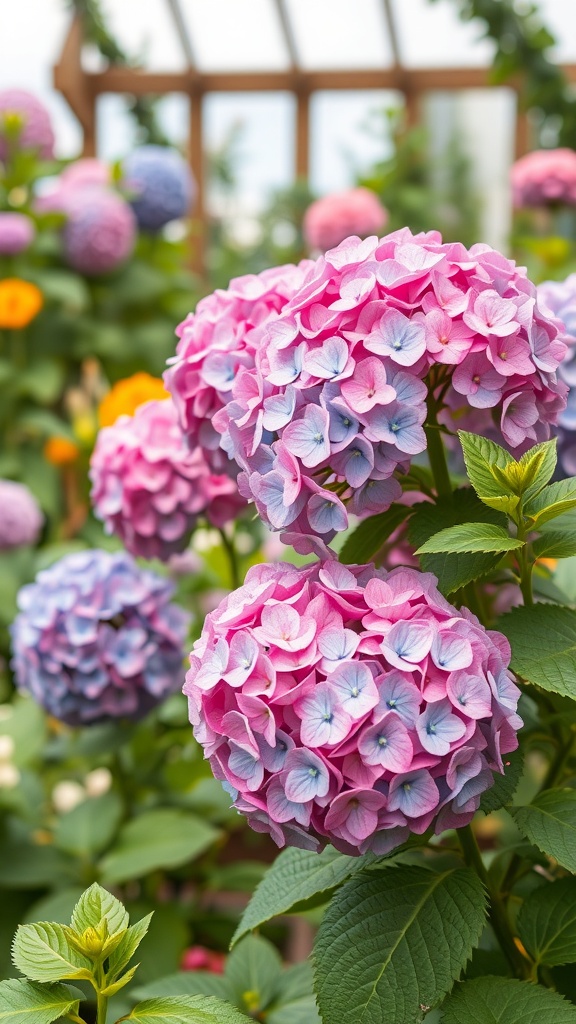
Hydrangeas are stunning flowers that bring a burst of color to any garden. Their large, round blooms come in various shades, making them a favorite for cut flower arrangements. In the image, you can see beautiful clusters of pink and blue hydrangeas, showcasing their unique color variations. These flowers can brighten up any space, whether in a garden or as part of a floral display.
Using hydrangeas as cut flowers is a great way to enhance your home decor. They can be arranged in vases, used in centerpieces, or even gifted to friends. Their long-lasting blooms mean you can enjoy their beauty for weeks. When designing your landscape, consider planting hydrangeas in groups to create a vibrant focal point.
These flowers thrive in various conditions, making them versatile for different garden styles. Whether you prefer a cottage garden or a more modern look, hydrangeas can fit right in. Their lush foliage and stunning blooms can create a welcoming atmosphere, perfect for outdoor gatherings.
Designing with Hydrangeas for Low-Maintenance Gardens
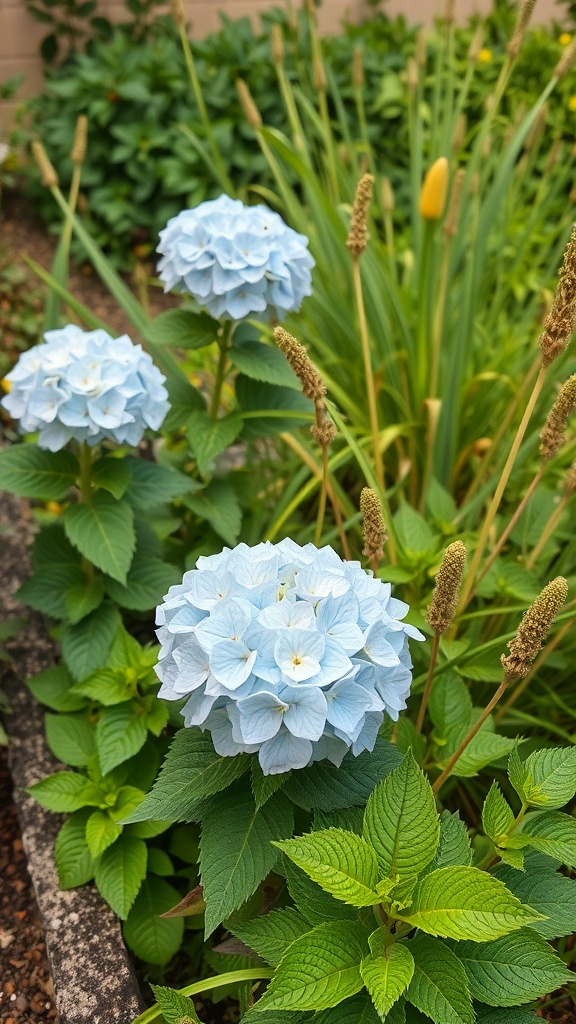
Hydrangeas are a fantastic choice for low-maintenance gardens. Their stunning blooms can brighten up any space without demanding too much attention. In the image, you can see beautiful blue hydrangeas surrounded by lush green foliage. This color adds a refreshing touch to the garden.
These flowers thrive in various conditions, making them versatile for different garden designs. They can grow well in partial shade and require minimal pruning. This means you can enjoy their beauty without spending hours on upkeep.
Incorporating hydrangeas into your garden layout can create a lovely focal point. Their round, full blooms contrast nicely with the slender grass-like plants in the background. This combination brings a sense of balance and harmony to the garden.
For those looking to create a serene outdoor space, hydrangeas are perfect. They provide a soft, calming presence that invites relaxation. Pairing them with other low-maintenance plants can enhance the overall look while keeping your garden easy to care for.
Creating Hydrangea Pathways and Borders
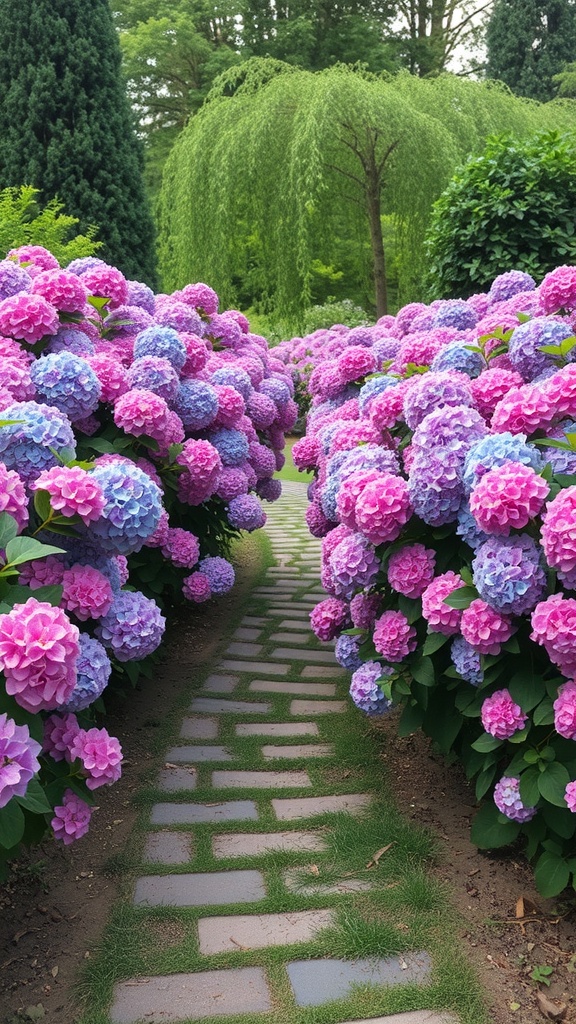
Creating pathways lined with hydrangeas can turn any garden into a stunning visual treat. The image shows a beautiful path flanked by vibrant clusters of pink and blue hydrangeas. These flowers not only add color but also create a welcoming atmosphere.
The pathway itself is made of smooth stones, providing a lovely contrast to the lush greenery. This design invites visitors to stroll through the garden, enjoying the beauty of the blooms. You can choose different varieties of hydrangeas to create a mix of colors and textures.
When planning your hydrangea pathways, consider the spacing between the plants. This allows them to grow without crowding each other. A well-placed border of hydrangeas can also help define the edges of your garden, guiding the eye and enhancing the overall design.
Incorporating pathways and borders with hydrangeas not only beautifies your space but also makes it functional. It encourages exploration and adds a touch of charm to your outdoor area. So grab your gardening tools and start planning your hydrangea pathway today!
